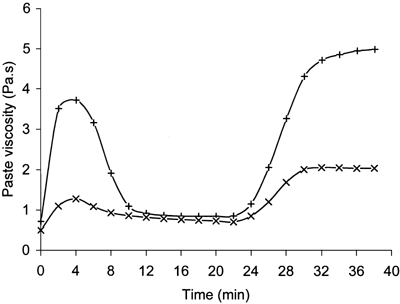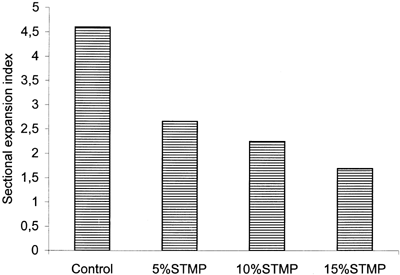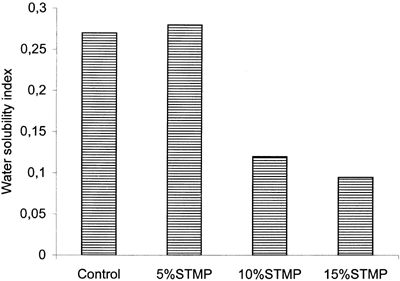Abstract
Starch was extruded in a single‐screw extruder with sodium hydroxide and three levels of sodium trimetaphosphate (STMP) as 5, 10, and 15% after moisture content was adjusted to 40%. The amount of phosphorus that was incorporated into starch during extrusion, paste viscosity, water solubility index, and sectional expansion index (SEI) of extrudates were determined. A pasting viscosity of phosphorylated starch showed that starch was cross‐linked with phosphorus that was incorporated into starch. The cross‐linking of starch with STMP and increasing the levels of STMP from 5 to 15% reduced the water solubility index and SEI of extrudates.
Introduction
Extrusion process is used to cook cereals in food industry. The extrusion of food material gelatinizes starch, denaturates protein, and heats water with a thermal energy from a barrel and a mechanical energy from friction. Bubbles in feed grow and expand when the product emerges from a die because of pressure difference. A volumetric expansion is an important factor in the texture of extruded products, and is the function of sectional and axial expansion. Melt viscosity, elasticity, and degradation of starch were reported as factors that affect the expansion of extrudates, but the effect of form of starch as native or modified on the expansion of extrudates was not reported.
Chinnaswamy and HannaCitation[1] showed that apparent viscosity of starch or flour affected the expansion ratio that reached a maximum value at viscosity of 3 kPa s and then decreased as apparent viscosity was varied. Wang et al.Citation[2] found that apparent density changed as apparent viscosity of dough changed, and Della Valle et al.Citation[3] reported a negative influence of melt viscosity on a volumetric expansion of extrudates. Melt viscosity of feed is stated as factor for the volumetric expansion, but elastic property of melt is considered as factor for the sectional expansion of extrudates.Citation[4]
HarperCitation[5] stated that elastic and expansion properties of starch and proteins decreased when they were damaged, and Alvarez‐Martinez et al.Citation[6] reported the decrease of a diametric expansion with the decrease of elastic characteristics when moisture content of feed was increased. In addition to the elastic properties of melt, the degradation of starch also was considered as factor for the sectional expansion.
Chinnaswamy and HannaCitation[7] found that increasing screw speed up to 150 rpm increased the sectional expansion ratio of normal corn starch, further increases in the screw speed reduced the expansion, and stated the reduction of expansion at the screw speeds apart from optimum as a result of lower gelatinization or starch degradation. The extend of degradation increase with increase in severity of extrusion.Citation[8] Chinnaswamy and HannaCitation[9] also showed that increasing length to diameter ratio (L/D) of a die nozzle from 2.5 to 3.4 enhanced the expansion ratio of corn starch, but further increases in L/D ratio reduced the expansion ratio because of starch degradation.
The extruder and process parameters not only affect the expansion but also extrudate physical properties like water solubility index. Tang and DingCitation[10] reported that water solubility index was positively correlated to a molecular degradation. Rutledge et al.Citation[11] investigated the effect of cross‐linking parboiled rice on the improvement of canning stability. They found that the cross‐linking of parboiled rice with sodium trimetaphosphate (STMP) decreased solid loss, which was part of rice lost by holding rice in water, as a result of increase in resistance to rupture.
The expansion property of starch is important in snack, fish foods and packaging foams, and was reported with experiments in which process parameters like screw speed and feed materialsCitation[12] were changed and to be found as factor to adjust the expansion of extrudates, but the form of starch was held constant. In this study, starch was cross‐linked with sodium hydroxide and STMP in the extruder. Water solubility index, which was stated as the indicator of starch degradation, and the sectional expansion of extrudates were determined at similar process parameters, but at native and cross‐linked starch extrudates in order to determine if form of starch is factor that can be used to adjust the expansion of extrudates.
Materials and Methods
Samples Preparation
Commercial corn starch (25% amylose) was granulated by spraying water on it while tumbling it in a rotating drum. A granulated starch was dried to moisture content of 10% (w/w) in a drying room at 40°C, and moisture content of a granulated starch was determined by an oven drying method.Citation[13] Starch is cross‐linked with NaOH and STMP in a batch system.Citation[14] The volume of 0.2 M sodium hydroxide that is required to adjust the pH of starch and water dispersion (1:1, w/w) to pH 10 was determined as it was done in a batch system.
The volume of sodium hydroxide, as determined above, and STMP at levels of 0.05, 0.1, and 0.15 kg per kg starch were mixed in order to prepare samples with 5, 10, and 15% STMP on a dry basis. A control sample was prepared without sodium hydroxide and STMP. Then water was added to adjust water content to 40% and mixed in a Hobart mixer for 5 min. After sample moisture contents were adjusted to the desired level, samples were stored at room temperature in sealed containers for 12 h of equilibration.
Extrusion Processing
A C. W. Brabender (Model No. 2802, C. W. Brabender Instruments Inc., South Hackensack, NJ) laboratory single‐screw extruder with compression ratio of 3:1 was used. A barrel diameter of the extruder was 0.019 m, and screw L/D ratio was 20. Increasing the barrel temperature from 130 to 175°C reduced the amount of phosphorus bound to starch by extrusionCitation[15] so the barrel temperature of the compression and die sections were held at 130°C. A screw speed was set at 140 rpm, and a 0.003 m diameter nozzle was used.
Phosphorus Content
Each extrudate sample was freed of soluble phosphates by washing twice with ethanol and water mixture (60%, v/v) and then drying. Phosphorus content was determined by the method of Smith and Caruso.Citation[16] For phosphorus analysis, 10 g sample was weighed into a dish.
Ten mL of zinc acetate solution (10%, w/w) was added to a dish, evaporated to dryness on a steam bath and hot plate, and placed in a muffle furnace at 550°C for 2 hr. After cooling, the dish was washed with 3 mL of nitric acid (29%, v/v). This sample was evaporated to dryness at the steam bath and hot plate and then ignited in the muffle furnace at 550°C for 30 min. The dish was washed with 10 mL nitric acid (29%, v/v) and 15 mL of water up on cooling. This solution was heated to boiling and held for 10 min at boiling temperature. After cooling, it was filtered. The filtrate was diluted to 3 mg of phosphorus per 25 mL by examining absorption of sample at 460 nm in a DU‐64 spectrometer (Model DU‐640, Beckman Instrument Inc., CA) after preparing calibration curve from absorption of known amount of phosphorus.
Each of nitric acid, ammonium vanadate (0.25%, w/w), and ammonium molybdate (5%, w/w) was added as 10 mL to the aliquot containing less than two and half mg of phosphorus. After mixing and waiting for 10 min, absorbance was measured with the spectrometer at 460 nm. Phosphorus content was determined from the calibration curve.
Paste Viscosity
Paste viscosity of starch was measured as centiPoise (cP) using a rapid Visco Analyzer (RVA) (Newport Scientific Pty. Ltd., Warriewood, Australia). A measured viscosity was converted to unit of Pa s. A 3 g sample of a dry extrudate was mixed with 25 g of water for a RVA analysis. The prepared sample was inserted into the RVA tower/holder and analyzed according to following procedure; equilibrated for 5 min at 25°C, heated over 5 min to a maximum temperature of 95°C, held at this temperature for 10 min, cooled to 25°C over 10 min and held at 25°C for 8 min.
Water Solubility Index
Extrudates were dried at 40°C in a drying room. Water solubility index was determined according to the method of Anderson et al.Citation[17] A two and half g sample of a ground extrudate (<60 mesh) was suspended in 30 mL of water at 30°C in a tarred centrifuge tube of 50 mL, stirred intermittently over 30 min period, and centrifuged at 3000g for 10 min. Supernatant liquid was poured into a tarred evaporating dish. Water solubility index was determined from the amount of dried solids recovered by evaporating the supernatant, and was expressed as gram dried solids per gram of sample.
Sectional Expansion Index
Sectional expansion index (SEI) values were calculated by EquationEq. (1), where D e = diameter of extrudate and D = diameter of die nozzle.
Experimental Design
Experiments were arranged as a randomized complete block design. Days were a blocking factor. Samples with three levels of STMP and without STMP as control were extruded. A total of four treatments were applied randomly to four samples. The experiment was repeated on different days, which were a blocking factor. Treatments were accepted as statistically effective when p value was equal and lower than 0.05.
Result and Discussion
Phosphorylation of Starch
The amounts of phosphorus in starch extrudates were shown in . Greater amount of phosphorus was found in extrudates obtained with the extrusion of starch, NaOH, and STMP than control starch extrudates obtained with the extrusion of starch alone. That shows the incorporation of phosphorus to starch with NaOH and STMP. Chang and LiiCitation[18] showed that the extrusion of starch with sodium tripolyphosphate enhanced the amount of phosphorus in starch extrudates.
Table 1. Phosphorus content of starch extrudates
Paste Viscosities of Extrudates
Paste viscosity of extrudate is used to determine the modification of starch. Paste viscosity of starch that was extruded with 5% STMP and NaOH was compared with the paste viscosity of control starch extrudate. A lower peak and setback peak viscosities, and shear thinning of starch extruded with STMP and NaOH compared to control starch extrudate showed that phosphorus, which was incorporated into starch, cross‐linked starch during extrusion ().
Figure 1. Paste viscosity of extrudates. Key: +, control; ×, starch extruded with 5% sodium trimetaphosphate.

Lim and Seib,Citation[14] Kasemsuvan and Jane,Citation[19] and Kartha and SrivastavaCitation[20] found that cross‐linking starch extensively in a batch system reduced the paste viscosity of starch. Cross‐linking starch in the extruder showed similar results to those from a batch system. The cross‐linking of starch reduces swelling, water absorption, and viscosity development so that the reduction of paste viscosity of starch with cross‐linking is observed.
Water Solubility Index
The control starch extrudate had similar water solubility index with extrudate of starch cross‐linked with 5% STMP, but higher water solubility index than the extrudate of starch cross‐linked with 10 and 15% STMP (p < 0.0005).
Sodium trimetaphosphate concentration affected water solubility index. Increasing STMP concentration from 5 to 15% reduced water solubility index (p < 0.0004) as shown in . Rutledge et al.Citation[21] stated that the cross‐linking of parboiled rice with STMP in a batch system decreased a solid loss of rice as a result of the reduction in the leaching of starchy solid material, and Rutledge et al.Citation[11] stated increase in the resistance of rice, which was cross‐linked in a batch system, to rupture.
Sectional Expansion Index
Control starch extrudates had higher SEI than the cross‐linked starch extrudates (p < 0.001), and increasing STMP concentration from 5 to 15% reduced the SEI (p < 0.01) as shown in .
Figure 3. Sectional expansion index of extrudates of control and starch cross‐linked at three sodium trimetaphosphate (STMP) concentrations.

The reduction of expansion with damage to starch and a molecular degradation were reported.Citation[4] Citation[5] Chinnaswamy and HannaCitation[7] and Chinnaswamy and HannaCitation[9] also stated the reduction of expansion as a result of starch degradation with increase in the screw speed and L/D ratio of a die nozzle. But the reduction of water solubility index and SEI with increase in STMP concentration, and a higher sectional expansion of control starch extrudate with a higher water solubility index were observed at 40% moisture content in our study. The determination of the effect of cross‐linking starch at lower moisture content on the sectional expansion of extrudates needs further study.
The effect of reduction in starch degradation with change in screw speed and L/D ratio on the sectional expansion of extrudates is different than the effect of reduction in water solubility index, indicator of starch degradation, with cross‐linking of starch on the sectional expansion of extrudates. The sectional expansion may not be linearly correlated to starch degradation or another property affects the sectional expansion of extrudates.
Alvarez‐Martinez et al.Citation[6] reported the decrease of sectional expansion with the reduction of elastic properties when moisture content of feed was increased and stated agreement with the propose of Launay and Lisch,Citation[22] the sectional expansion is related to melt elasticity. The effect of elastic property of melt at varying moisture content on the sectional expansion was stated, but the measurement of elastic properties of melt was not reported.
Conclusions
A paste viscosity of starch, which was extruded with sodium hydroxide and trimetaphosphate, showed that starch was cross‐linked with phosphorus incorporated with sodium hydroxide and trimetaphosphate during extrusion. Cross‐linking starch and increasing STMP concentration reduced a SEI and water solubility index. This result showed that the SEI was not increased with the reduction of water solubility index by cross‐linking starch with sodium hydroxide and trimetaphosphate.
References
- Chinnaswamy , R. and Hanna , M. A. 1990 . Relationship between viscosity and expansion properties of variously extrusion‐cooked corn grain components . Food Hydrocolloids , 3 : 423 – 434 .
- Wang , S. , Casulli , J. and Bouvier , J. M. 1994 . Effect of dough ingredients on apparent viscosity and properties of extrudates in twin screw extrusion‐cooking . Int. J. Food Sci. , 28 : 465 – 479 .
- Della Valle , G. D. , Vergnes , B. , Colonna , P. and Patria , A. 1997 . Relations between rheological properties of molten starches and their expansion behaviour in extrusion . J. Food Eng. , 31 : 277 – 296 .
- Desrumaux , A. , Bouvier , J. M. and Burri , J. 1998 . Corn grit particle size and distribution effects on the characteristics of expanded extrudates . J. Food Sci. , 63 : 857 – 863 .
- Harper , J. M. 1986 . Extrusion texturization of foods . Food Technol. , 40 : 70 – 72 .
- Alvarez‐Martinez , L. , Koundury , K. P. and Harper , J. M. 1988 . A general model for expansion of extruded products . J. Food Sci. , 53 : 609 – 615 .
- Chinnaswamy , R. and Hanna , M. A. 1988 . Optimum extrusion‐cooking conditions for maximum expansion of corn starch . J. Food Sci. , 53 : 834 – 836 . 840
- Guha , M. and Ali , S. Z. 2002 . Molecular degradation of starch during extrusion cooking of rice . Int. J. Food Prop. , 5 : 509 – 521 .
- Chinnaswamy , R. and Hanna , M. A. 1987 . Nozzle dimension effects on the expansion of extrusion cooked corn starch . J. Food Sci. , 52 : 1746 – 1747 .
- Tang , D. and Ding , X. L. 1994 . Relationship between functional properties and macromolecular modifications of extruded corn starch . Cereal Chem. , 71 : 364 – 369 .
- Rutledge , J. E. , Islam , M. N. and James , W. H. 1972 . Improved canning stability of rice by chemical modification . Cereal Chem. , 49 : 430 – 436 .
- Gujral , H. S. and Singh , N. 2002 . Extrusion behavior and product characteristics of brown and milled rice grits . Int. J. Food Prop. , 5 : 307 – 316 .
- Chinnaswamy , R. and Hanna , M. A. 1988 . Relationship between amylose content and extrusion‐expansion properties of corn starches . Cereal Chem. , 65 : 138 – 143 .
- Lim , S. and Seib , P. A. 1993 . Preparation and pasting properties of wheat and corn starch phosphates . Cereal Chem. , 70 : 137 – 144 .
- Salay , E. and Ciacco , C. F. 1990 . Production and properties of starch phosphates produced by extrusion process . Starch , 42 : 15 – 17 .
- Smith , R. J. and Caruso , J. L. 1964 . “ Determination of phosphorus ” . In Methods in Carbohydrate Chemistry Edited by: Whistler , R. L. 42 – 44 . New York : Academic Press .
- Anderson , R. A. , Conway , H. F. , Pfeifer , V. H. and Griffin , E. L. 1969 . Gelatinization of corn grits by roll and extrusion cooking . Cereal Sci. Today , 14 : 4 – 7 . 11 – 12 .
- Chang , Y.‐H. and Lii , C.‐H. 1992 . Preparation of starch phosphates by extrusion . J. Food Sci. , 57 : 203 – 205 .
- Kasemsuvan , T. and Jane , J. 1994 . Location of amylose in normal starch granules . Cereal Chem. , 71 : 282 – 287 .
- Kartha , K. P.R. and Srivastava , H. C. 1985 . Reaction of epichlorothydrin with carbohydrate polymers . Starch , 37 : 270 – 279 .
- Rutledge , J. E. , Islam , M. N. and James , W. H. 1974 . Improved canning stability of parboiled rice through cross‐linking . Cereal Chem. , 51 : 46 – 51 .
- Launay , B. and Lisch , J. M. 1984 . “ Twin‐screw extrusion cooking of starches: flow behaviour of starch pastes, expansion and mechanical properties of extrudates ” . In Extrusion Cooking Technology Edited by: Jowitt , R. 159 – 160 . London : Applied Science Pub., Ltd. .
